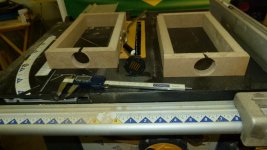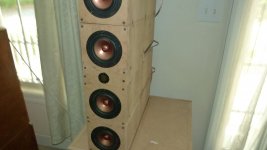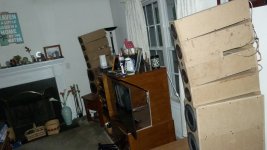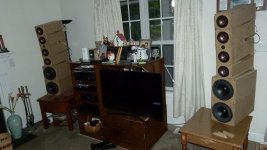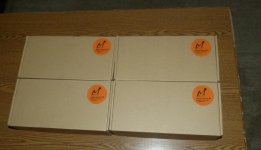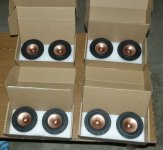I was so impressed, 8 more Pluvia's are on order. That'll be 8 per side. Looking more like an array now as the title suggests.
I was so impressed, 8 more Pluvia's are on order. That'll be 8 per side. Looking more like an array now as the title suggests.
Hmm... getting more interesting. 🙂
It's good nothing is glued together yet.
The plan is to disassemble the Pluvia enclosures and cut them in half depthwise. This will yield the quickest 16 enclosures. Currently there's 8 and they're 20" deep with internal volume of .31 cu.ft. and vented. The new boxes will be sealed or vented, testing is needed to see which sounds best. They should go down to 100Hz. But at least they will be light! The 20" boxes are 11lbs.
All enclosures will be modified such that the Pluvia drivers will be as close as possible when vertically stacked, so figure about internal volume of .13 cu.ft.
Also, I have plans to build a sort of stand for each array that will allow vertical 'aiming' of each speaker, when not stacked closely together although it will allow for that too. More on the stand later.😉 The 2 SB Acoustics 8" subwoofers will be stacked on the bottom.
Today I'm working on the simple task of an enclosure for the AMT tweeters.
The plan is to disassemble the Pluvia enclosures and cut them in half depthwise. This will yield the quickest 16 enclosures. Currently there's 8 and they're 20" deep with internal volume of .31 cu.ft. and vented. The new boxes will be sealed or vented, testing is needed to see which sounds best. They should go down to 100Hz. But at least they will be light! The 20" boxes are 11lbs.
All enclosures will be modified such that the Pluvia drivers will be as close as possible when vertically stacked, so figure about internal volume of .13 cu.ft.
Also, I have plans to build a sort of stand for each array that will allow vertical 'aiming' of each speaker, when not stacked closely together although it will allow for that too. More on the stand later.😉 The 2 SB Acoustics 8" subwoofers will be stacked on the bottom.
Today I'm working on the simple task of an enclosure for the AMT tweeters.
Last edited:
At the very least you should also move the stacked boxes to the front of the tables. This appears to be evolving into something very interesting. Whether you continue with it, or move on to something else, it looks like you've caught the bug, and minidsp could serve you very well all the way along your journey- just be prepared for a bit of a learning curve there as well.
..... squirrel
..... squirrel
Looking good. What are the bass drivers used at the bottom part?
I mistakenly said they were Dayton's a few posts ago. They're SB Acoustics 8" subs in a 10"x8.5"x20" box. I'm really tempted to make 4 more, so 4 per side. They're powered by a separate amp.
After stuffing the vents in each of the Pluvia boxes, the bass is now much more present. Must've been some cancelling going on between the two types of drivers.
At the very least you should also move the stacked boxes to the front of the tables....
..... squirrel
I just got materials needed to make 2 more subwoofers, also 2"+ spikes to make a plate in order to keep the subwoofers off of the floor. Now they will have a place in the corners, and I'll start on the (2) speaker stands.
Also on order egg crate foam to finally insulate all 16 Pluvia enclosures.
Lots of work to do this coming Wed!
Here's some pics of the new MarkAudio drivers. Nicely packaged with precut gasket material and 'hex/Allen' mounting screws.
Attachments
Not the best for subwoofers or fullrangers?Not the best damping material.
dave
What would you recommend Dave, for the new enclosures?
I have no internal damping now, and I'm seeing a small hump around 400Hz. After I make the new boxes (.15 cu.ft. vs .32 cu.ft.), I guess the resonances would most likely double and approach 1kHz?
I have no internal damping now, and I'm seeing a small hump around 400Hz. After I make the new boxes (.15 cu.ft. vs .32 cu.ft.), I guess the resonances would most likely double and approach 1kHz?
For sealed enclosures i would recommend volume fill with acoustic-stuff. We also like to line the cabinet walls near the driver with ½” ultratouch cotton felt (wool felt serves the same purpose)
dave
dave
For sealed enclosures i would recommend volume fill with acoustic-stuff. We also like to line the cabinet walls near the driver with ½” ultratouch cotton felt (wool felt serves the same purpose)
dave
I don't mean to task you Dave, only because I already sprung for $85 of the egg crate foam for the Pluvia enclosures, but why is this unacceptable in your experience?
I will do testing.. I appreciate your input, I really do although it's abit vague...
The only option I will have is a bare box vs a box with egg crate foam comparison and observe the frequency response and report back on the differences.
The only option I will have is a bare box vs a box with egg crate foam comparison and observe the frequency response and report back on the differences.
I will do testing.. I appreciate your input, I really do although it's abit vague...
The only option I will have is a bare box vs a box with egg crate foam comparison and observe the frequency response and report back on the differences.
I did some impedance comparisons of various damping materials in my thread and I found that 25mm egg crate foam lining the walls of the (fairly small) enclosure did a pretty good job of damping the resonances seen in the impedance plot. It performed about at well as 10mm felt in the same application. The polyester fill did very little in comparison to fibreglass when it came to lowering the Q from stuffing.
If the enclosure is just for a sub then lining the walls with the foam will do a reasonable job of damping the resonances, most will be outside the pass band anyway so might not even be excited. The pluvia cabinets would probably benefit more from a bit of fibreglass or similar materials.
Changes in the impedance response from cabinet issues can be easier to see so it is a worthwhile measurement to make that can be done with REW and a few connectors and a resistor.
Last edited:
I did some impedance comparisons of various damping materials in my thread and I found that 25mm egg crate foam lining the walls of the (fairly small) enclosure did a pretty good job of damping the resonances seen in the impedance plot. It performed about at well as 10mm felt in the same application. The polyester fill did very little in comparison to fibreglass when it came to lowering the Q from stuffing.
If the enclosure is just for a sub then lining the walls with the foam will do a reasonable job of damping the resonances, most will be outside the pass band anyway so might not even be excited. The pluvia cabinets would probably benefit more from a bit of fibreglass or similar materials.
Changes in the impedance response from cabinet issues can be easier to see so it is a worthwhile measurement to make that can be done with REW and a few connectors and a resistor.
Thanks! I see where you did those tests on your array.
- Status
- Not open for further replies.
- Home
- Loudspeakers
- Full Range
- Mini Tower Line Array using Pluvia 7's
